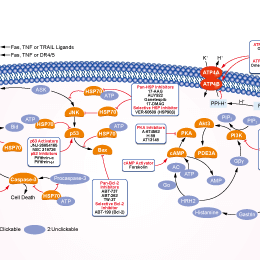
- Bioactive Compounds
- By Signaling Pathways
- PI3K/Akt/mTOR
- Epigenetics
- Methylation
- Immunology & Inflammation
- Protein Tyrosine Kinase
- Angiogenesis
- Apoptosis
- Autophagy
- ER stress & UPR
- JAK/STAT
- MAPK
- Cytoskeletal Signaling
- Cell Cycle
- TGF-beta/Smad
- DNA Damage/DNA Repair
- Compound Libraries
- Popular Compound Libraries
- Customize Library
- Clinical and FDA-approved Related
- Bioactive Compound Libraries
- Inhibitor Related
- Natural Product Related
- Metabolism Related
- Cell Death Related
- By Signaling Pathway
- By Disease
- Anti-infection and Antiviral Related
- Neuronal and Immunology Related
- Fragment and Covalent Related
- FDA-approved Drug Library
- FDA-approved & Passed Phase I Drug Library
- Preclinical/Clinical Compound Library
- Bioactive Compound Library-I
- Bioactive Compound Library-Ⅱ
- Kinase Inhibitor Library
- Express-Pick Library
- Natural Product Library
- Human Endogenous Metabolite Compound Library
- Alkaloid Compound LibraryNew
- Angiogenesis Related compound Library
- Anti-Aging Compound Library
- Anti-alzheimer Disease Compound Library
- Antibiotics compound Library
- Anti-cancer Compound Library
- Anti-cancer Compound Library-Ⅱ
- Anti-cancer Metabolism Compound Library
- Anti-Cardiovascular Disease Compound Library
- Anti-diabetic Compound Library
- Anti-infection Compound Library
- Antioxidant Compound Library
- Anti-parasitic Compound Library
- Antiviral Compound Library
- Apoptosis Compound Library
- Autophagy Compound Library
- Calcium Channel Blocker LibraryNew
- Cambridge Cancer Compound Library
- Carbohydrate Metabolism Compound LibraryNew
- Cell Cycle compound library
- CNS-Penetrant Compound Library
- Covalent Inhibitor Library
- Cytokine Inhibitor LibraryNew
- Cytoskeletal Signaling Pathway Compound Library
- DNA Damage/DNA Repair compound Library
- Drug-like Compound Library
- Endoplasmic Reticulum Stress Compound Library
- Epigenetics Compound Library
- Exosome Secretion Related Compound LibraryNew
- FDA-approved Anticancer Drug LibraryNew
- Ferroptosis Compound Library
- Flavonoid Compound Library
- Fragment Library
- Glutamine Metabolism Compound Library
- Glycolysis Compound Library
- GPCR Compound Library
- Gut Microbial Metabolite Library
- HIF-1 Signaling Pathway Compound Library
- Highly Selective Inhibitor Library
- Histone modification compound library
- HTS Library for Drug Discovery
- Human Hormone Related Compound LibraryNew
- Human Transcription Factor Compound LibraryNew
- Immunology/Inflammation Compound Library
- Inhibitor Library
- Ion Channel Ligand Library
- JAK/STAT compound library
- Lipid Metabolism Compound LibraryNew
- Macrocyclic Compound Library
- MAPK Inhibitor Library
- Medicine Food Homology Compound Library
- Metabolism Compound Library
- Methylation Compound Library
- Mouse Metabolite Compound LibraryNew
- Natural Organic Compound Library
- Neuronal Signaling Compound Library
- NF-κB Signaling Compound Library
- Nucleoside Analogue Library
- Obesity Compound Library
- Oxidative Stress Compound LibraryNew
- Plant Extract Library
- Phenotypic Screening Library
- PI3K/Akt Inhibitor Library
- Protease Inhibitor Library
- Protein-protein Interaction Inhibitor Library
- Pyroptosis Compound Library
- Small Molecule Immuno-Oncology Compound Library
- Mitochondria-Targeted Compound LibraryNew
- Stem Cell Differentiation Compound LibraryNew
- Stem Cell Signaling Compound Library
- Natural Phenol Compound LibraryNew
- Natural Terpenoid Compound LibraryNew
- TGF-beta/Smad compound library
- Traditional Chinese Medicine Library
- Tyrosine Kinase Inhibitor Library
- Ubiquitination Compound Library
-
Cherry Picking
You can personalize your library with chemicals from within Selleck's inventory. Build the right library for your research endeavors by choosing from compounds in all of our available libraries.
Please contact us at info@selleckchem.com to customize your library.
You could select:
- Antibodies
- Bioreagents
- qPCR
- 2x SYBR Green qPCR Master Mix
- 2x SYBR Green qPCR Master Mix(Low ROX)
- 2x SYBR Green qPCR Master Mix(High ROX)
- Protein Assay
- Protein A/G Magnetic Beads for IP
- Anti-Flag magnetic beads
- Anti-Flag Affinity Gel
- Anti-Myc magnetic beads
- Anti-HA magnetic beads
- Poly DYKDDDDK Tag Peptide lyophilized powder
- Protease Inhibitor Cocktail
- Protease Inhibitor Cocktail (EDTA-Free, 100X in DMSO)
- Phosphatase Inhibitor Cocktail (2 Tubes, 100X)
- Cell Biology
- Cell Counting Kit-8 (CCK-8)
- Animal Experiment
- Mouse Direct PCR Kit (For Genotyping)
- New Products
- Contact Us
(-)-Blebbistatin
ATPase inhibitor
research use only
(-)-Blebbistatin ((S)-(-)-Blebbistatin) is a cell-permeable inhibitor for non muscle myosin II ATPase with IC50 of ~2 μM in cell-free assays, does not inhibit myosin light chain kinase, inhibits contraction of the cleavage furrow without disrupting mitosis or contractile ring assembly.
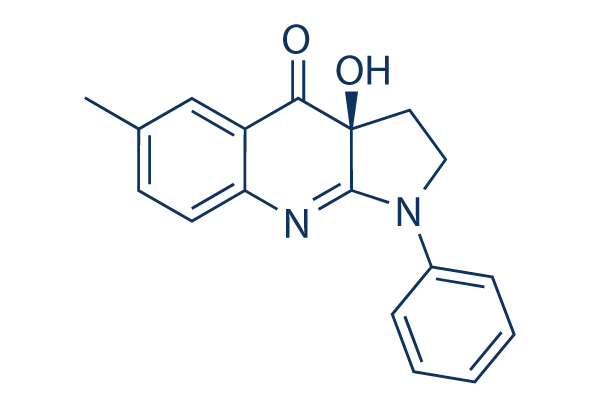
(-)-Blebbistatin Chemical Structure
Molecular Weight: 292.33
Purity & Quality Control
Batch:
Purity:
99.82%
99.82
(-)-Blebbistatin Related Products
| Related Targets | V-ATPase F-ATPase SERCA RecA AAA ATPase family | Click to Expand |
|---|---|---|
| Related Products | Brefeldin A (BFA) CB-5083 Omecamtiv mecarbil (CK-1827452) Thapsigargin Sodium orthovanadate Golgicide A BTB06584 Ginsenoside Rb1 CDN1163 Periplocin Rhodamine 123 tetrathiomolybdate Saikosaponin D | Click to Expand |
| Related Compound Libraries | FDA-approved Drug Library Natural Product Library Ion Channel Ligand Library Exosome Secretion Related Compound Library Calcium Channel Blocker Library | Click to Expand |
Signaling Pathway
Cell Culture and Working Concentration
| Cell Lines | Assay Type | Concentration | Incubation Time | Formulation | Activity Description | PMID |
|---|---|---|---|---|---|---|
| Rh41 | qHTS assay | qHTS of pediatric cancer cell lines to identify multiple opportunities for drug repurposing: Confirmatory screen for Rh41 cells | 29435139 | |||
| SK-N-MC | qHTS assay | qHTS of pediatric cancer cell lines to identify multiple opportunities for drug repurposing: Primary screen for SK-N-MC cells | 29435139 | |||
| NB-EBc1 | qHTS assay | qHTS of pediatric cancer cell lines to identify multiple opportunities for drug repurposing: Primary screen for NB-EBc1 cells | 29435139 | |||
| Click to View More Cell Line Experimental Data | ||||||
Mechanism of Action
| Description | (-)-Blebbistatin ((S)-(-)-Blebbistatin) is a cell-permeable inhibitor for non muscle myosin II ATPase with IC50 of ~2 μM in cell-free assays, does not inhibit myosin light chain kinase, inhibits contraction of the cleavage furrow without disrupting mitosis or contractile ring assembly. | ||
|---|---|---|---|
| Targets |
|
In vitro |
||||
| In vitro | Blebbistatin, inhibits cytokinesis, alters the smooth movement of fish keratocytes and inhibits the spontaneous blebbing of a cell line lacking filamin. Blebbistatin is shown to inhibit the enzymatic activities of HMM fragments of nonmuscle myosin IIA, nonmuscle myosin IIB and of rabbit skeletal muscle myosin S1, but not smooth muscle myosin[1] Blebbistatin rapidly and reversibly inhibits Mg-ATPase activity and in vitro motility of non-muscle myosin IIA and IIB for several species, while poorly inhibiting smooth muscle myosin (IC50 = 80 μM). Blebbistatin potently inhibits Dictyostelium myosin II, but poorly inhibits Acanthamoeba myosin II. Blebbistatin does not inhibit representative myosin superfamily members from classes I, V, and X. [2] Blebbistatin does not compete with nucleotide binding to the skeletal muscle myosin subfragment-1. The inhibitor preferentially binds to the ATPase intermediate with ADP and phosphate bound at the active site, and it slows down phosphate release. Blebbistatin interferes neither with binding of myosin to actin nor with ATP-induced actomyosin dissociation. Instead, it blocks the myosin heads in a products complex with low actin affinity. [3] |
|||
|---|---|---|---|---|
| Kinase Assay | Actin-activated MgATPase assay | |||
| Actin-activated MgATPase activity is measured using an NADH-coupled assay in a Beckman DU 640 spectrophotometer. Blebbistatin [a racemic mixture of the (+) and (-) enantiomers] is added from stocks dissolved in DMSO and the DMSO concentration is maintained at a constant concentration of 5% in all samples. | ||||
| Cell Research | Cell lines | MDCK and U2OS cells | ||
| Concentrations | 25 µM | |||
| Incubation Time | 2-4 h | |||
| Method | Cells were treated with vlebbistatin for 2-4 hours. |
|||
| Experimental Result Images | Methods | Biomarkers | Images | PMID |
| Western blot | talin 1 / vinculin / paxillin paxillin / pY31 paxillin / pY397FAK / FAK PY epitopes / vinculin / paxillin |
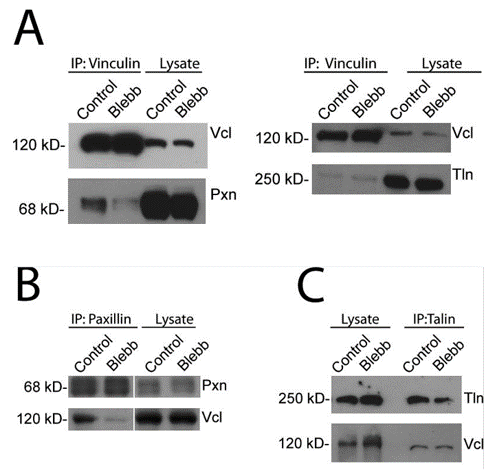
|
20308429 | |
| Growth inhibition assay | Cell viability Cell death |
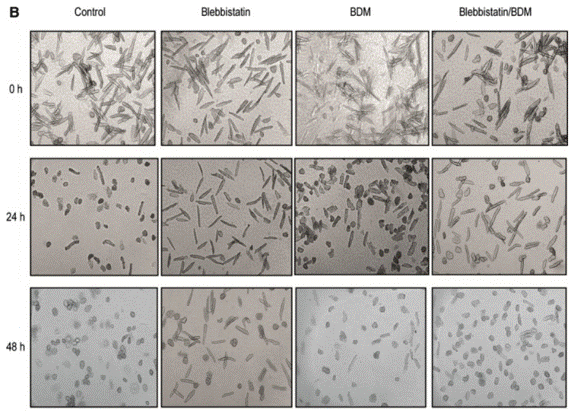
|
26733241 | |
| Glycerol/urea gel electrophoresis | RLC phosphorylation RLC phosphorylation RLC phosphorylation |
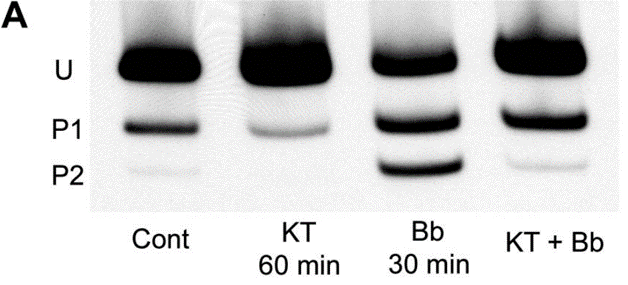
|
18701651 | |
| DIC image | Traction force of a palladin KD (Palld4) cell |
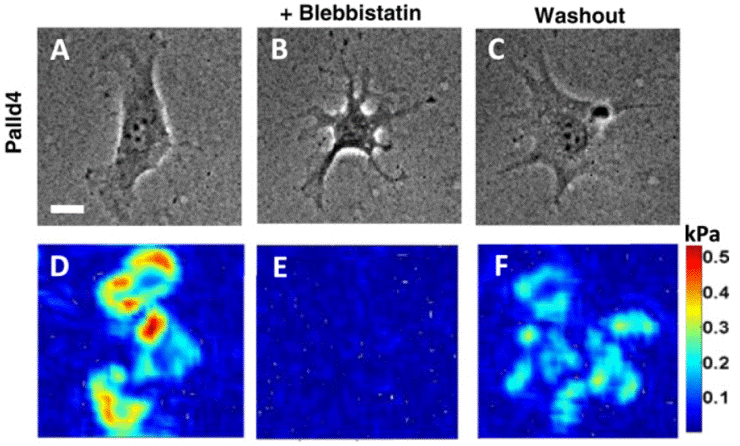
|
27353427 | |
| Immunofluorescence | GCs morphology actin / NMIIA / tubulin VE-cadherin / F-actin PY epitopes / actin PY epitopes / paxillin talin 1 / FAK / β1 integrin / zyxin / vinculin / α-actinin / paxillin |

|
25598228 | |
In Vivo |
||
| In vivo | (-)-Blebbistatin ((S)-(-)-Blebbistatin) is a cell-permeable inhibitor for non muscle myosin II ATPase. |
|
|---|---|---|
| Animal Research | Animal Models | Male Sprague–Dawley rats (TBI model) |
| Dosages | 10 mg/kg | |
| Administration | i.p. | |
References |
|
Chemical Information
| Molecular Weight | 292.33 | Formula | C18H16N2O2 |
| CAS No. | 856925-71-8 | SDF | Download (-)-Blebbistatin SDF |
| Synonyms | (S)-(-)-Blebbistatin | ||
| Smiles | CC1=CC2=C(C=C1)N=C3C(C2=O)(CCN3C4=CC=CC=C4)O | ||
Storage and Stability
| Storage (From the date of receipt) | 3 years -20°C(in the dark) powder | ||
|
In vitro |
DMSO : 39 mg/mL ( (133.41 mM) Moisture-absorbing DMSO reduces solubility. Please use fresh DMSO.) Water : Insoluble Ethanol : Insoluble |
Molecular Weight Calculator |
|
In vivo Add solvents to the product individually and in order. |
In vivo Formulation Calculator |
|||||
Preparing Stock Solutions
Molarity Calculator
In vivo Formulation Calculator (Clear solution)
Step 1: Enter information below (Recommended: An additional animal making an allowance for loss during the experiment)
mg/kg
g
μL
Step 2: Enter the in vivo formulation (This is only the calculator, not formulation. Please contact us first if there is no in vivo formulation at the solubility Section.)
% DMSO
%
% Tween 80
% ddH2O
%DMSO
%
Calculation results:
Working concentration: mg/ml;
Method for preparing DMSO master liquid: mg drug pre-dissolved in μL DMSO ( Master liquid concentration mg/mL, Please contact us first if the concentration exceeds the DMSO solubility of the batch of drug. )
Method for preparing in vivo formulation: Take μL DMSO master liquid, next addμL PEG300, mix and clarify, next addμL Tween 80, mix and clarify, next add μL ddH2O, mix and clarify.
Method for preparing in vivo formulation: Take μL DMSO master liquid, next add μL Corn oil, mix and clarify.
Note: 1. Please make sure the liquid is clear before adding the next solvent.
2. Be sure to add the solvent(s) in order. You must ensure that the solution obtained, in the previous addition, is a clear solution before proceeding to add the next solvent. Physical methods such
as vortex, ultrasound or hot water bath can be used to aid dissolving.
Tech Support
Answers to questions you may have can be found in the inhibitor handling instructions. Topics include how to prepare stock solutions, how to store inhibitors, and issues that need special attention for cell-based assays and animal experiments.
Tel: +1-832-582-8158 Ext:3
If you have any other enquiries, please leave a message.
* Indicates a Required Field






































